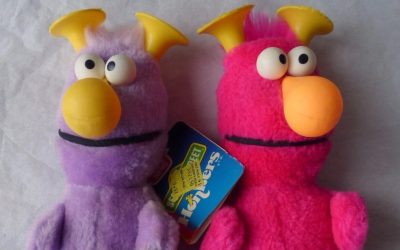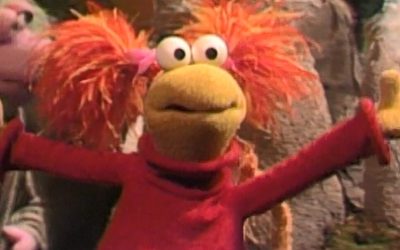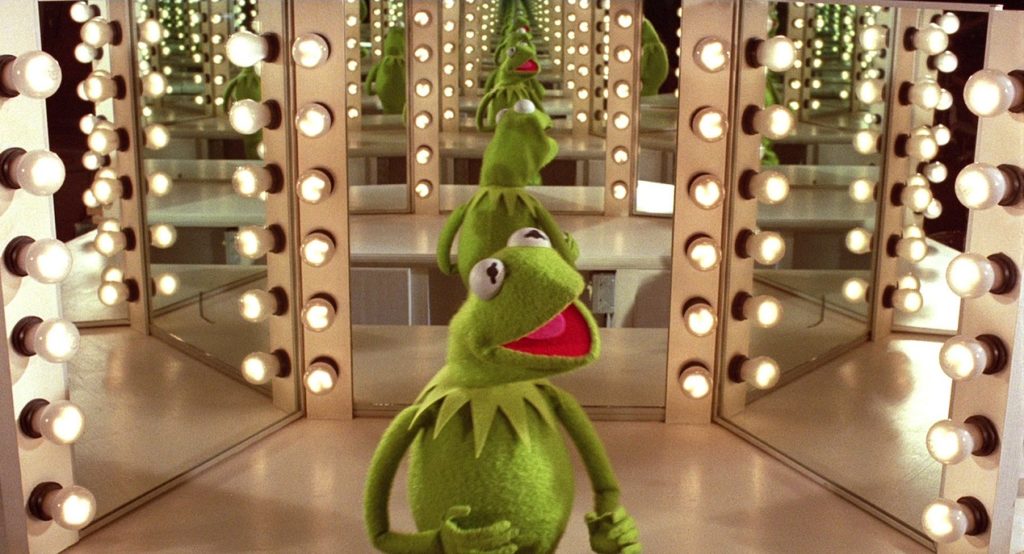Part 1 – Part 2 – Part 3 – Part 4
While writing the first article in this series, I realized I’d made a big mistake.
To argue for the incongruity of Labyrinth, I started typing up a description of a scene in which the dialogue and the visuals were in conflict with one another, or so I thought. It’s near the beginning when Sarah asks Hoggle where the door is to the labyrinth, and he tells her she’s not asking the right questions. Then she asks, “How do I get into the labyrinth?” Ah-ha! Hoggle can answer this question!
It seemed to me that whoever wrote that dialogue placed some key information in it for the set designer: Sarah expects there to be a door, but that’s just Sarah taking things for granted. Gee, assuming this is a coherent movie in which the designers paid attention to the script so the film’s audio and visuals wouldn’t contradict each other, they must have come up with a really neat way for Sarah to get into the labyrinth that isn’t doors!
It’s doors.
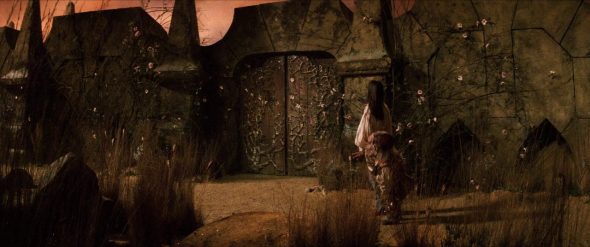
The irony of ironies is that it was I, your humble narrator, who was taking things for granted. Sarah’s question wasn’t necessarily wrong for assuming there was a door. It may have been wrong for assuming there was a singular, universal entrance to the labyrinth. There may be many ways into the labyrinth. Maybe it’s something different for everyone.
Different fans of Labyrinth get into it for different reasons. Part of me likes to think that there’s a way in for most anybody, and some poor suckers just haven’t found it yet. That part of me is dead wrong, but it’s the part of the human spirit all fanatics indulge when they shout about their love for their favorite things into the abyss that is the internet. Please humor me accordingly. Let’s try knocking on a few doors to see if one of them is yours!
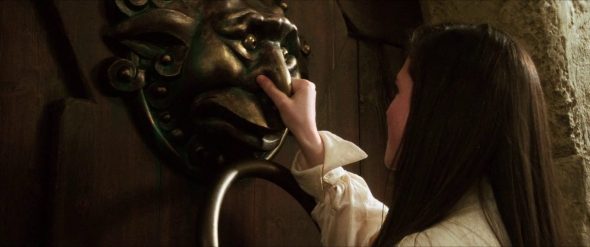
Door #1: Labyrinth as a Study of Fiction
In the second article in this series, I wrote about how Labyrinth doesn’t really come to an agreement with itself on how much of it is fictionally true and how much of it is fantasy or illusion, and doesn’t really need to. Somehow, it’s able to tell a story with an emotional logic to it, with good setups and payoffs no less, all without having a cannon. I’ve already come around to take issue with parts of that article, naturally, but I do still think the movie is simply taking the logic of fictional narratives as we know them (that is, tailoring a world to the story of the protagonist) to the logical conclusion. The result is a story about what it’s like to be fictional.
You see, it’s not just that the fantasy world Sarah enters runs together with her “real” world. There’s another world in this movie, or possibly more than one: Sarah’s fiction. You know, the play that she’s performing at the beginning? It becomes interchangeable with her real life. What about the bedtime story she tells Toby? It immediately becomes interchangeable with her real life. Her life is the story she tells herself.
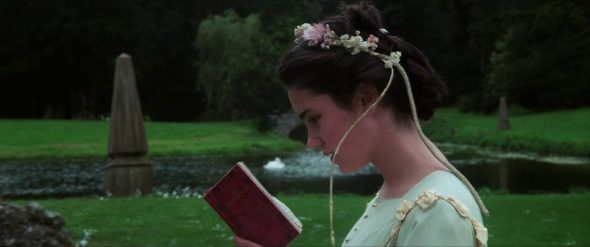
Yet, it is never her goal to escape her underground world to find the least fictional world and see the light of truth outside Plato’s cave. Quite contrarily, to gain insight, she must go further and further down into her fiction and her fantasy until she reaches the center. In the end, it is reciting the line from her play, thereby fully becoming the fictional character, that puts an end to Jareth.
With this in mind, I offer J.D.’s Bonkers Reading 2. I argued in my second article that the whole movie is a dream. Everything between the credits. I just didn’t say whose dream. Maybe it’s the one character who inspires this whole story, yet is never seen: the princess. In this reading, the story Sarah tells Toby is the fictional truth, and the princess has dreamt herself as Sarah, a girl in the suburbs of 1980s New England in a world where magic only exists in children’s stories.
Is this reading advisable? Heck no, but maybe it’s your way into Labyrinth! Maybe that’s your door! However, I’d like to float a more obvious reading your way. At least it seems obvious to me, but I haven’t noticed anyone talking about it.
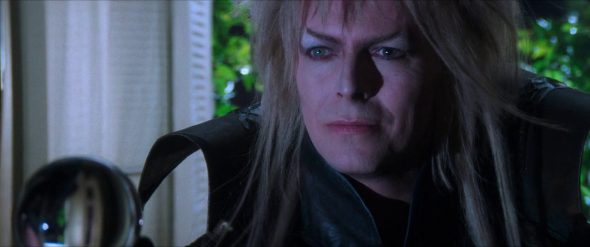
Door #2: Not Really My Door, but a Much Needed Door
It’s been bugging me for at least six years. Somebody needs to do a queer theory reading of Labyrinth. I probably should not be the one to do it, so I won’t get into it here, but, needless to say, it should affect one’s reading of the film that Sarah’s deepest fantasy is wearing lipstick and eye makeup and a wig, and that’s he’s played by David Bowie of all people. Gosh, I can’t wait to read an article about that. Please send all of your wishes that this article was that article instead to the address at the bottom of the page. For now though, here’s the reading I know how to write.
Door #3: The Easy-Peasy Reading
So, do you remember that part when Sarah mugs a little man and mocks him for his shortness? She’s a jerk then. That’s part of her realization that the labyrinth, and perhaps life itself, is not fair, “and that’s the way it is.” If she stopped at that epiphany, she’d probably still be a jerk in the end. It’s usually a safe bet that the people who go around saying, “Hey, life’s not fair, and that’s the way it is,” are jerks. However, in an earlier scene, the guards tell her, “You’re right, it’s not fair, but that’s only half of it!” The half that matters is what you do in an unfair world to work towards well-being anyway, and I think that often starts with reorganizing yourself.
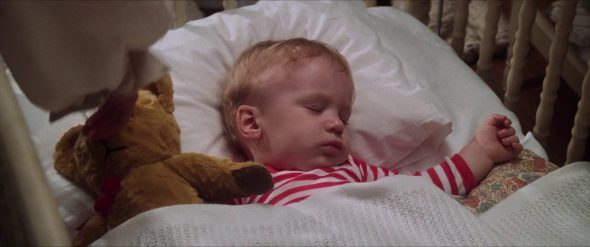
At the start of the movie, Sarah’s fantasizing through her fiction is her escape from reality. In the junk scene, a key change occurs: instead of distracting her from Toby, the same words become her reminder of Toby. It turns out, within her escapist junk and fairy stories, there was a grain of her true values. Because of this, she is able to weaponize fiction against Jareth in their showdown. Her fantasy is hers, not something that governs her, once she decides to use it for what’s really important.
This kicks off the film’s resolution, which is Sarah’s sorting process. She gives Toby the teddy bear, perhaps because she’s realized that people are more important than things, or perhaps because she’s ready to let go of some of her childhood. Probably both! She puts away the play, having used it for what she needed from it. She puts away the music box, having experienced becoming this childhood fantasy of womanhood and broken free from it. Then, several characters from her fantasy life appear in her reflection, and she confesses that she needs them.
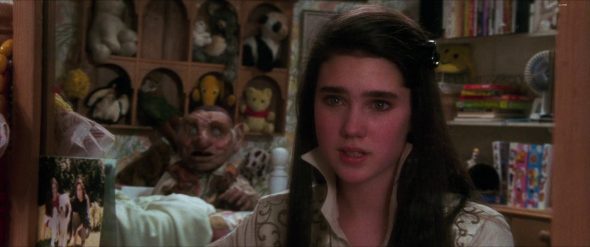
As cheesy as the ending may be, I like that it’s okay for her to need them. Our entertainment and our childhood fantasies don’t need to be expelled from our lives in order for us to mature, but we do need to wrestle with our relationship to them. We should use them to remember our values, take whatever else we need from them to feel okay and to be ourselves, and set aside the rest so we can focus on creating well-being.
I think this is more or less the general understanding of the film these days. My ego would like you to know that this might possibly be the effect of my 2018 video essay about Labyrinth. Yet, with all the words that have ever been written about Labyrinth, most of them probably being mine, I haven’t really explored what any of it has to do with me, at least not until………. now!
Door #4: My Door
I’m sure I was first drawn to this movie because, as a kid, I wanted to love everything Jim Henson did. The making-of featurette was such a big part of my attachment to this film, but even without that, there was a power to this film. Without relying much on jump scares or horror movie cliches, it was still the first movie to make me literally shaky in the knees from the chills. I liked the music, which has only grown on me with time, and I liked Sarah and her friends. Yet, the thing that’s stuck with me is how this movie knows me too well. I’m such a helpless escapist.
I am writing this in a room filled with Muppet crap. Much of it was given to me as gifts and has sentimental value. Much of it is random. It’s on my shelf because I don’t have a better place for it, and, darn it, I can’t seem to part with it. You know what happens every time I start setting some aside to get rid of it, or even to put it away? My brain starts playing the song “Home at Last”, the heart-wrenchingly sad piece Trevor Jones wrote for the part of this movie when Sarah gets home. It nearly breaks me every time. Good lord, this movie is staring into my eyes like my own reflection, or like the apparition of Ludo that’s suddenly standing behind my reflection. Not the time, my dude!
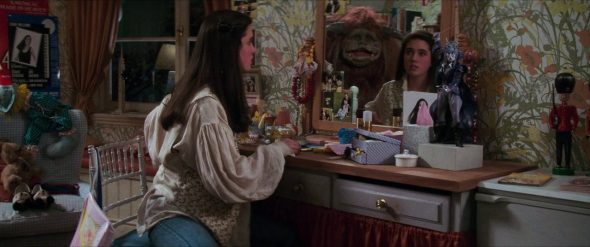
It’s not just the merch though. It’s all of it. How much of my life have I given to making media about Muppets? Certainly more than I’ve spent helping real people, or doing any work that speaks to my values and the world I’d like to help create. So, I now find myself in the process of organizing myself. I’ve been at it for several months. (Note that I haven’t published a ToughPigs article since October.) In all honesty, this process is super freaking hard.
Ah, but Labyrinth. I watch this movie, and I start to think that maybe I can do it. Maybe it’s possible to find the balance. Maybe I can make good choices about how much media and how many silly projects I should put away, and what’s worth it to me to keep. Maybe I have that power.
To me, that makes Labyrinth the most powerful movie the Henson crew ever made. That may not always be my door, but for today, that’s my door. What’s yours?
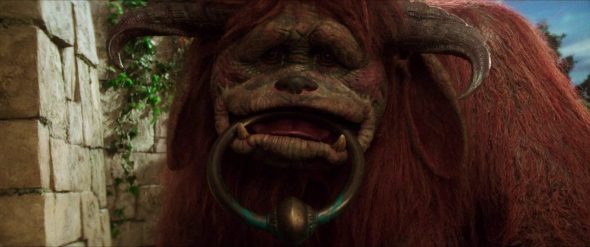
Click here to wonder how I made it through an article about my door without mentioning The Cube on the ToughPigs Forum!
by J.D. Hansel – jdhansel@toughpigs.com

